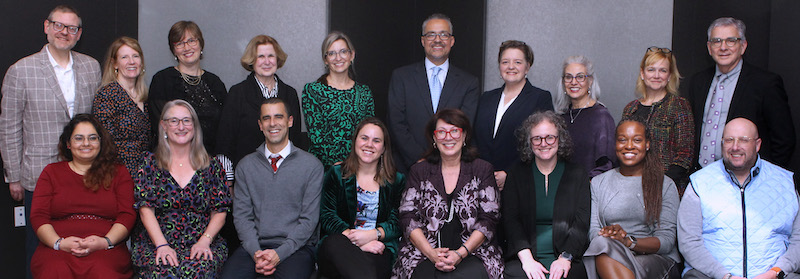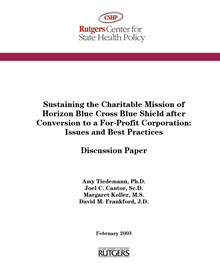Site Search
- resource provided by the Forum Network Knowledgebase.
Search Tip: Search with " " to find exact matches.
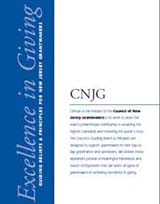
This includes insights and tips related to board governance, legal compliance, grantee communications, fiscal responsibility, public disclosure, and many other key areas of foundation governance and operations. It is intended to serve as a practical resource to assist foundations in their grantmaking.
Welcome to the Council of New Jersey Grantmakers’ Foundation Funding Map, where members have free access to accurate, up-to-date grantmaking data critical to smart, strategic giving that makes the biggest impact.
The data shown on the map is from CNJG member and non-member foundations, corporate giving programs and others that have submitted their grants data through this Get on the Map! Campaign. The greater the number of funders that submit their data, using the template, the more complete this picture of how funds are distributed in New Jersey will be.
Responding Post Sandy: Philanthropic Relief & Recovery
Superstorm Sandy officially came ashore in New Jersey on October 29, 2012 at 8:00 p.m. and its aftermath continues to be felt in communities throughout our state. Not 24 hours after the storm made landfall, CNJG began planning a series of actions to help inform funders what to be prepared for, share information and discuss strategies. CNJG's support of the philanthropic community as it navigates the shifting landscape of disaster recovery, continues.
CNJG has been working closely with their philanthropic members in New Jersey and their philanthropic colleagues from around the nation who have experience in disaster philanthropy, as well as working cooperatively with the Governor’s Office on Recovery, FEMA, NJ State Police Office of Emergency Management, NJ Voluntary Organizations Active in Disaster, NJ’s Long Term Recovery Group Leaders, and NJ’s leading nonprofit organizations.
Post Sandy Funder Briefings
Beginning one week after Sandy struck New Jersey CNJG launched a weekly conference call series for grantmakers to hear from policymakers, disaster relief/recovery experts and colleagues who have been through similar catastrophes. Grantmakers heard from nearly 70 guest speakers including policymakers, disaster relief and recovery experts, and statewide and national foundation leaders that have experienced similar catastrophes. The briefings provided an opportunity to connect directly with local leaders and state officials addressing the many needs of our communities. Grantmakers learned about issues related to both disasters in general and Sandy recovery in particular. Topics included housing, mental health, social justice, universal design, FEMA’s National Disaster Recovery Framework, and an array of environmental issues. All of the calls were recorded and also transcribed into concise written summaries and are available on our website.
Series 1 ran from November 2012 -- March 2013
Series 1 Audio Recordings
Series 1 Written Summaries
Series 2 ran from September 2013 -- November 2013
Series 2 Audio Recordings
Series 2 Written Summaries
Series 1 & 2 Written Compendium
Funders’ Briefing Post Sandy Recovery at 18 months
 With support from the Jon Bon Jovi Soul Foundation and OceanFirst Foundation, CNJG presented a specific briefing on housing, hunger and mental health recovery efforts and needs 18 months after the storm. We heard personal stories from families that were displaced and their long struggle to rebuild and recoup. We heard insights from service providers on the long term effects of Sandy. Several Long Term Recovery Groups described some of their ongoing challenges, but also shared what was working.
With support from the Jon Bon Jovi Soul Foundation and OceanFirst Foundation, CNJG presented a specific briefing on housing, hunger and mental health recovery efforts and needs 18 months after the storm. We heard personal stories from families that were displaced and their long struggle to rebuild and recoup. We heard insights from service providers on the long term effects of Sandy. Several Long Term Recovery Groups described some of their ongoing challenges, but also shared what was working.
CNJG’s response to Superstorm Sandy also included
Coastal Communities Site Visit Tours
CNJG offered its members a rare opportunity to tour several of the disaster-affected communities in Monmouth and Ocean Counties and to hear from those on-the-ground. Throughout the day, twelve guest speakers representing all areas of the effort, including individuals from FEMA, local and state government, Long Term Recovery Group leaders, city and state planners, environmental professionals, social services personnel, and faith-based leaders, among others spoke to a group of 60 philanthropic leaders. Building upon the first successful Coastal Communities Site Visit Tour, CNJG offered a similar program focusing on communities in northern New Jersey – specifically the hard hit areas in Essex, Hudson and Bergen Counties. In addition to hearing from a wide range of local officials, Long Term Recovery Group Leaders, urban planners, and environmental experts, the site visit included a tour of a PSEG sub-power station which was flooded.
Statewide Conference
Bringing together an incredible community of funders, providers and practitioners for a day of exploration, shared learning and discussion at the Spring 2013 Conference for the Social Sector - Our Shared Road Ahead: Sandy and Beyond on June 10. The Conference provided participants with an important opportunity to hear about the lessons learned by social sector colleagues and experts around the country who have grappled with how to create effective long-term philanthropic responses to catastrophic events in the absence of a readily available guide.
Superstorm Sandy Philanthropic Investments Scan
Philanthropy & Hurricane Sandy: A Report on the Foundation & Corporate Response is a report released in October 2014 by CNJG and partners that examines the response of foundations, corporations, and other institutional donors to the devastation wrought by Hurricane Sandy in October 2012. Numbering nearly 600, these funders have so far committed more than $380 million for relief, recovery and building efforts. The hard data and reflective observations in the report contribute to the growing body of knowledge that helps foundations and corporations be strategic and effective with their giving when disaster strikes.
Two years after the historic storm, this report breaks down the allocation of dollars contributed thus far and offers perspective on the role of private giving in disaster response and lessons to be taken from this one. The report was published by the Foundation Center in partnership with the Council of New Jersey Grantmakers and Philanthropy New York, and with support from the Center for Disaster Philanthropy.
Special thanks to our philanthropic partners that have supported various aspects of the Council’s work beginning immediately after Hurricane Sandy struck through our ongoing work today, including: the Center for Disaster Philanthropy, Citi, Fund for New Jersey, The Henry & Marilyn Taub Foundation, The Horizon Foundation for New Jersey, Hurricane Sandy New Jersey Relief Fund, JCP&L, JPMorgan Chase, Jon Bon Jovi Soul Foundation, The Merck Company Foundation/Merck & Company, Inc., PSEG Foundation, Provident Bank Foundation, Rita Allen Foundation, Subaru, TD Bank, United Way of Essex and West Hudson, Verizon NJ, and the Victoria Foundation.
Eastside High School in Paterson sits in the middle of a struggling neighborhood, in a city where 25% of the residents are living below the poverty line, according to the 2020 U.S. Census.
Paterson’s poverty rate is more than twice the state average of 10%, which makes the school, built in 1926, a refuge — and now a resource.
On Thursday, Montclair State University president Jonathan Koppell came to Eastside with a $1 million grant and a vision: to make the school into a community hub, offering free meals, health care, and mental health counseling, not just to the 2,000 students, but to their families as well.
The initiative is called One Square Mile, and it is being seeded with a $1 million grant from the Geraldine R. Dodge Foundation. The program was developed by Koppell during his tenure as Dean of the Watts College of Public Service and Community Solutions at Arizona State University, which worked with the Phoenix-area community of Maryvale to address poverty.
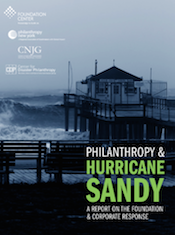
This new report from CNJG and partners examines the response of foundations, corporations, and other institutional donors to the devastation wrought by Hurricane Sandy in October 2012. Numbering nearly 600, these funders have so far committed more than $380 million for relief, recovery and building efforts. The hard data and reflective observations in the report contribute to the growing body of knowledge that helps foundations and corporations be strategic and effective with their giving when disaster strikes.
Two years after the historic storm, Philanthropy & Hurricane Sandy: A Report on the Foundation & Corporate Response breaks down the allocation of dollars contributed thus far and offers perspective on the role of private giving in disaster response and lessons to be taken from this one. The report was published by the Foundation Center in partnership with the Council of New Jersey Grantmakers and Philanthropy New York, and with support from the Center for Disaster Philanthropy.
“Throughout the past two years, our exceptional nonprofit and funder community has taken on challenges they never imagined,” said Nina Stack, president of the Council of New Jersey Grantmakers. “These organizations continue to develop innovative solutions that other communities will learn from and build upon in future disasters.”
In addition to the report’s numerous funders, CNJG wishes to thank the PSEG Foundation for supporting this project.
Novartis benchmarked Employee Crisis Programs, and asked fellow corporate funders via the corporate funders listserve to answer the questions below.
- If you have an Employee Crisis Program, what is the name
- Do you manage the program internally or thru a 3rd party? If you use a 3rd party, can you share their name/website and any good/bad experiences.
- Do you only support disasters or other hardships as well?
- What is the average percentage of your employees that apply for aid?
- What is your minimum and maximum funding?
- What is the average amount of aid?
- Do you provide aid directly to the employee and/or vendors?
- Do you allow employees to donate to your fund? If so, how do you promote awareness and what is the employee donation participation rate? Do you match these donations?
- Where does the program reside (CSR, Foundation, HR)?
- Please share guidelines and applications, if possible.
- Please share any other insights.
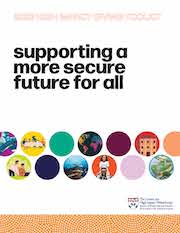
The CNJG board is comprised of 20 leaders who come from CNJG member organizations and are elected by the CNJG membership. Each board member provides guidance and leadership to CNJG by serving up to two 3-year terms.
Photo taken after CNJG Annual Meeting on December 11, 2024.
Back Row: Andy Fraizer, Christine Healey, Lucy Vandenberg, Patricia Hartpence, Aaron Turner, Craig Drinkard, Catherine Wilson, Margarethe Laurenzi, Tammy Rice Herman, and Paul DiLorenzo
Front Row: Priti Mehta, Melissa Litwin, Justin Kiczek, Kate Barrett, Theresa Jacks (CNJG), Marcy Felsenfeld, Jasmyne Beckford, and Jeremy Grunin
Not Pictured: Kortney Swanson Davis, Maisha Simmons, and Maria Spina.
CNJG Board Members
Craig Drinkard, Chair, Victoria Foundation
Justin Kiczek, 1st Vice Chair, F. M. Kirby Foundation
Christine Healey, 2nd Vice Chair, The Healey Education Foundation, Inc.
Catherine Wilson, Treasurer, United Way of Greater Newark
Kortney Swanson Davis, Secretary, Forman S. Acton Educational Foundation
Kate Barrett, The Campbell’s Foundation
Jasmyne Beckford, The Prudential Foundation
Paul DiLorenzo, Salem Health and Wellness Foundation
Marcy Felsenfeld, The Healthcare Foundation of New Jersey
Andy Fraizer, Community Foundation of South Jersey
Jeremy Grunin, Grunin Foundation
Patricia Hartpence, NJM Insurance Group
Tammy Rice Herman, New Jersey State Council on the Arts
Margarethe Laurenzi, Maher Charitable Foundation
Melissa Litwin, The Henry and Marilyn Taub Foundation
Priti Mehta, Investors Foundation
Maisha Simmons, Robert Wood Johnson Foundation
Maria Spina, PSEG Foundation
Aaron Turner, Community Foundation of New Jersey
Lucy Vandenberg, Schumann Fund for New Jersey
Theresa Jacks, President & CEO, Council of New Jersey Grantmakers – ex officio
The Board of Trustees are supported by the work of 8 different committees.
Multi-year Grants
Affirmation: Multi-year funds provided both reliability and breathing room for nonprofits.
Making fundamental and long-lasting change comes with the promise of reliable investments. Longer grant terms create an environment where collaborative partnerships can flourish, and trust and transparency break down power dynamics. The result is that nonprofits have the “breathing room” and financial stability to focus activities where they are most needed.
Although many funders award grants to the same nonprofits year after year, they often require submission of annual applications that request information they already have and are complex and needlessly lengthy. These processes can heighten mutual distrust. From a practical standpoint, multi-year awards reduce paperwork for both funder and nonprofit and open communication channels promoting shared goals, mutual trust, and increased overall impact.
Activities
• For funders that historically award repeat annual grants to the same nonprofit partners, shift from an annual grant/proposal cycle to a long-term, multi-year commitment with an annual outcomes/progress report in lieu of a full application.
• Tailor grant terms to suit grantee timelines and needs (negotiated outcomes and milestones).
• If data collection is required solely to meet a funder’s compliance requirements, the funder should assume this responsibility or provide sufficient funding and/or capacity for the nonprofit to meet the requirement.
Short-term Outcomes
• The number of funders making multi-year grants increases by 50% over the previous years.
Long-term Outcomes
• More funders convert an annual application process for repeat grantee partners to a multi-year commitment with an annual outcomes report at the most, instead of full proposals each year.
• Funders assume responsibility for data collection or provide sufficient funding and/or capacity for the nonprofit to meet the requirement.
• Grant terms are suited to grantee timelines and needs (negotiated outcomes and milestones).
How to Begin Doing Good Better on Reliability
Learning opportunities
• What barriers keep funders from making long-term commitments to repeat grantee partners? Are any of these barriers legal?
• What are the minimum data requirements for funders to collect from repeat grantee partners?
Pre-Work
• Address the barriers to awarding multi-year grants through tested tools.
• Learn about how multi-year grants strengthen grantee partners and improve philanthropic, nonprofit, and community impact.
• Research mechanisms funders can use to meet legal compliance requirements while gaining trust in their grantee partners.
"Co-Creation" is a case study about the Connecticut Early Childhood Funder Collaborative, a project of the Connecticut Council for Philanthropy. The case study, written by Patricia Bowie, examines co-creation, an emerging systems change collaboration model which grew out of a funder-and-state partnership. This unique partnership led to the creation by executive order of a new and independent Office of Early Childhood, which was formally approved by the Connecticut State Legislature in 2013. The companion piece, "Taking on New Roles to Address 21st Century Problems," looks at co-creation from the perspective of a regional association of grantmakers.
The Connecticut Early Childhood Funder Collaborative comprises 14 funders from around the state who bring many years of experience in supporting and operating programs that serve the needs of children and families.
Strategic asset allocation is arguably one of the most important, yet least advanced, aspects of investing. The Investment Strategy Group (ISG) in the Goldman Sachs Investment Management Division has developed a new approach to strategic asset allocation, which leverages the idea that long-term investment returns derive from multiple distinct sources called “return-generating factors.” This multi-factor approach is designed to help investors better understand the key sources of long-term return across asset classes and to increase the precision of long-term risk and return estimates. It also provides investors with a new way to think about portfolio diversification, allowing them to focus not only on diversification across asset classes but also
on diversification across the underlying sources of return.
As we move beyond the election season and look to 2025, New Jersey’s philanthropic and nonprofit sectors will continue to engage in conversations and partnerships that inspire change and support an inclusive future for all. Ensuring that we are fully prepared for the work ahead demands curiosity, an openness to ongoing learning, a commitment to listening, and building relationships with a range of partners. These are key characteristics and traits of a true leader.
To help you navigate what’s next in a new administration and new Congress, several national partners are offering post-election analysis:
- The National Council of Nonprofits is hosting Impact of the Elections on Nonprofitson Tuesday, November 12 at 4 pm.
- The Council on Foundations is hosting Looking to 2025: Making Sense of the Elections on Thursday, November 14 at 2 pm.
- United Philanthropy Forum is hosting Decision '24 Post-Election Briefing: Debrief + Sector Outlook on Wednesday, November 20 at 12:00 pm.
Leaders are committed to exploring new ideas, building connections, and finding common ground, and ways to come together. The New Jersey Center for Nonprofits’ annual conference, The Road Ahead on Wednesday, December 4 will bring together social sector leaders from across the state for just these purposes. I encourage you to register as soon as possible if you plan on attending. Space is filling up quickly.
Leaders come from all walks of life, and we’re especially fortunate in the philanthropic sector to have an abundance of talented, thoughtful, and caring leaders. After connecting with social sector leaders, and building on your leadership acumen at the Center’s conference, we’re looking forward to seeing you at the CNJG Annual Meeting & Holiday Gathering on December 11. Our theme, Inspiring Change through Leadership: Maximizing Philanthropic Impact, could not be more timely.
As a leader, you know that in these complex times, philanthropic investment and commitment matter more than ever. Each of us, and our individual organizations, bring unique and deeply informed expertise, perspectives, influence, and skills that enrich our collective effort. Together, New Jersey’s philanthropic community will continue to build a space where all voices are heard, and collaboration is valued, so we can move forward to address critical issues in meaningful ways.
Underwriting or sponsoring convenings is another strategy to engage in leadership activities. I hope you will consider supporting the annual meeting of the CNJG membership with a sponsorship or special donation. This event is the one time per year when a significant number of Council members come together in one space, often sowing the very first seeds of collaboration. Learn more about sponsorship opportunities.
A big thank you to our sponsors to date - we couldn't do this without you! Special thanks to Signature Sponsor – Prudential; Contributing Sponsors – Devils Youth Foundation, Robert Wood Johnson Foundation, and Victoria Foundation; Supporting Sponsor – Grunin Foundation, Pincus Family Foundation, and WSFS Bank; and Colleague Sponsor – Horizon Blue Cross Blue Shield of New Jersey.
Wishing us all a safe, restful, and restorative Thanksgiving later this month when the campaign of 2024 becomes a distant memory, but our resolve to champion the causes that matter most to our communities remains steadfast. That’s what leaders do.
Warmly,
Theresa Jacks, President and CEO
Council of New Jersey Grantmakers
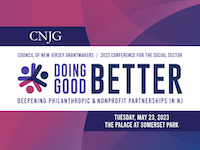
Date: Tuesday, May 23
Time: 8:00 a.m. to 4:00 p.m.
Location
The Palace at Somerset Park
333 Davidson Ave, Somerset, NJ
The Council of New Jersey Grantmakers is pleased to present our 2023 Conference for the Social Sector on May 23, 2023. The conference theme will focus on our initiative: Doing Good Better, a partnership between the Council of New Jersey Grantmakers and the New Jersey Center for Nonprofits. This long-term initiative aims to shift the culture of the New Jersey philanthropic and nonprofit ecosystem by encouraging funders, nonprofits, and government to create shared power rooted in collaboration, mutual trust, and respect.
The 2023 Spring Conference for the Social Sector: Doing Good Better will explore how funders and nonprofits can address philanthropy’s power imbalances, rethink traditional grantmaking practices to better serve New Jersey communities, and position equity as a driving force. For many years, but particularly in the context of the COVID-19 pandemic, natural disasters, and the heightened outcry for racial equity and social justice, funders have been urged to embrace more flexibility and transparency in their grantmaking. Practices such as general operating support, simplified application and reporting procedures, multi-year funding and others have been shown to level the power imbalance, advance greater equity, strengthen partnerships between funders and their nonprofit partners, and thereby improve community impact. The conference will present strategies and tools including trust-based philanthropy, participatory grantmaking, power redistribution, and others that we can all employ to inform and realign processes, systems, and culture in the social sector. Join foundation, philanthropic, government, and nonprofit colleagues to learn about and leverage these tools. Together, we will discover and strategize how we collectively can "do good better”.
| Agenda | |
| 8:00 - 9:00 am | Registration/Breakfast/Networking/Resource Marketplace |
| 9:00 10:00 am | Opening Plenary |
| 10:00 - 10:15 am | Networking & Resource Marketplace |
| 10:15 - 11:30 am | Breakout Sessions |
| 11:30 - 11:45 am | Networking & Resource Marketplace |
| 11:45 - 1:00 pm | Luncheon Plenary |
| 1:00 - 1:30 pm | Table Discussions |
| 1:30 - 1:45 pm | Networking & Resource Marketplace |
| 1:45 - 3:00 pm | Breakout Sessions |
| 3:00 - 4:00 pm | Ice Cream reception/Networking/Resource Marketplace |
This weekly funder briefing webinar series welcomed New Jersey-based grantmakers along with national funders and provided an opportunity for grantmakers to hear from a wide range of nonprofit experts. This series started on March 13, 2025, less than a month after the first executive order was issued and continued through April 24, 2025. The written summaries of each recording are listed below.
In 2003, with member support, CNJG commissioned a report on the impact a potential conversion of Horizon Blue Cross Blue Shield to a for-profit might have on access to health care in New Jersey. Research from the Center for State Health Policy (CSHP) at Rutgers University, provided details about the law governing such conversions in New Jersey and the experience of other states with conversions. The report identified questions raised in other states when such conversions occur, especially about the valuation of assets, the impact on low-income families, and the operation of the philanthropic foundations that have been established as stewards of the assets generated by the conversions. CNJG’s purpose was to seek answers to critical questions relevant to the availability of healthcare coverage for New Jersey’s citizens and to discuss models of best practice for healthcare conversion foundations across the United States.


